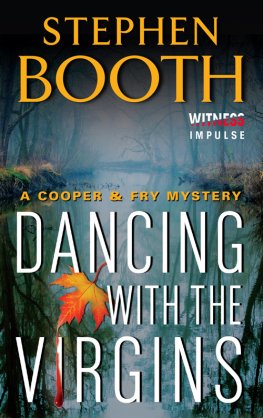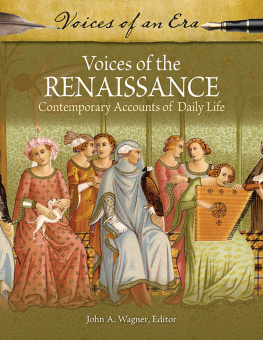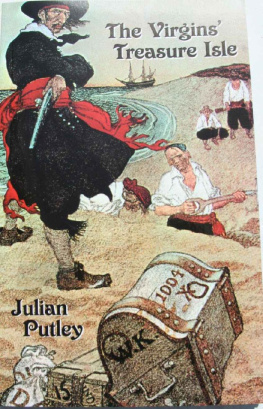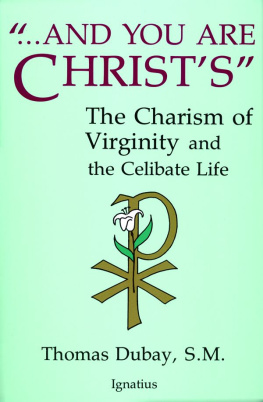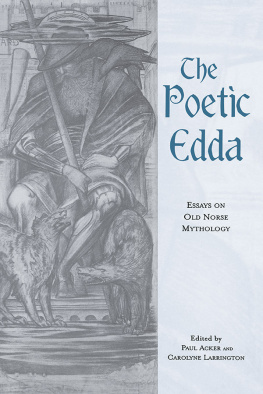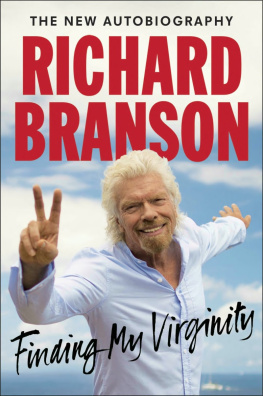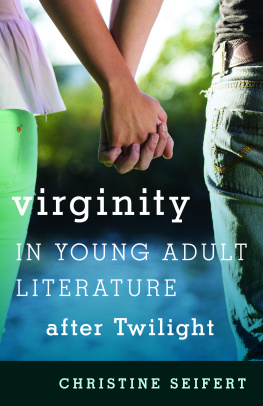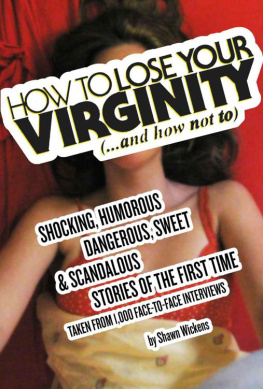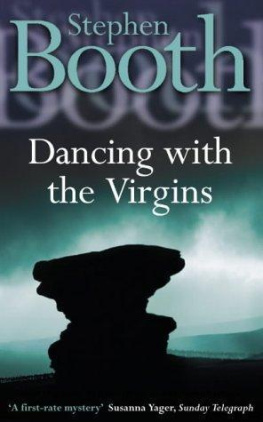

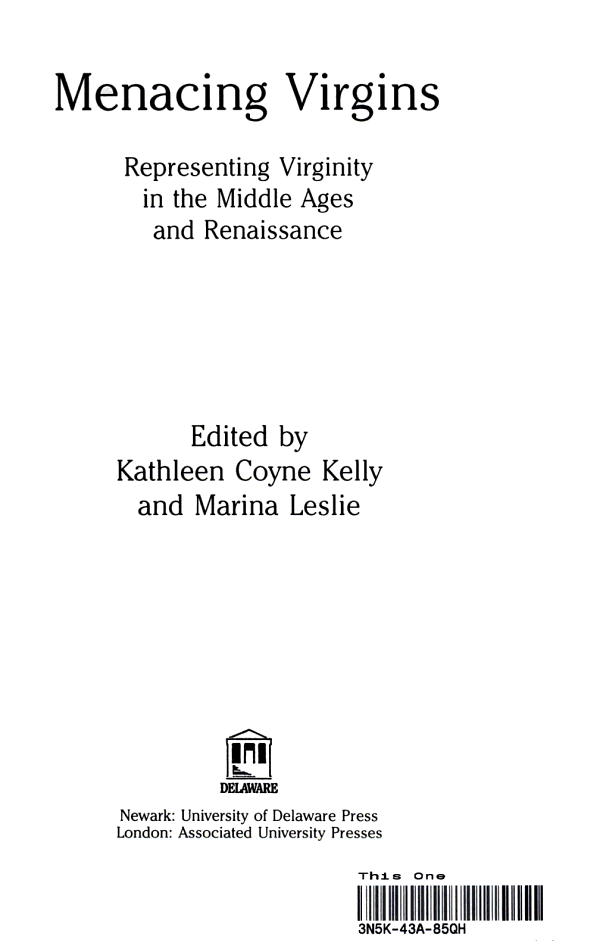
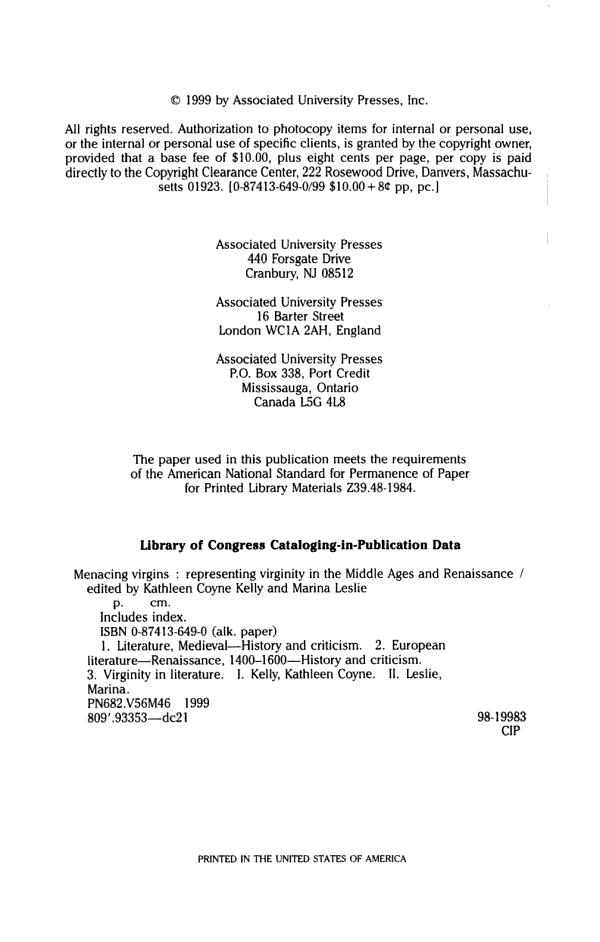
Foreword
Margaret W. Ferguson
Waiting for the gynecologist, thinking about this collection of incisive essays on medieval and Renaissance representations of virginity, and leafing through one of the magazines provided for women who wait in doctors' offices, I was stunned to see in large, bold type the word "Virgin" above a picture of a naked baby; the caption recommended a certain brand of diapers with the arresting claim that "virgin" means "never before used." The highly fanciful etymology (according to the OED, at least, the English word "virgin" and its Romance language cognates derive from the accusative form of the Latin virgo, meaning "maiden") seemed worthy of Isidore of Seville, although he might have been surprised to find the phrase "never before used" suggestively explaining the "virgin" virtues both of a buxom baby (gender not revealed in the photo) and a brand of disposable plastic diaper. What struck me as most bizarre about the advertisementand also most germane to the many paradoxical aspects of what counts as "virginity" as analyzed in the book you are readingwas the implicit economic and cultural message to acquire and USE the virgin item. The excessiveness, the transgresssive weirdness, of the advertisement's implied logic of virginity, a logic that caught the baby body as well as the diaper in its loop, only served to dramatize a psycho-economic feature typical of many of the notions of virginity we have inherited from the past: the virgin item's cultural value lies partly in the fact that it has not yet been used: the specter of an imminent or eventual use, consumption, or violation is indeed central to many cultural conceptions of virginity from the Middle Ages to the present.
Western notions of virginityand of its allied but by no means always synonymous concept, chastity1have historically been knotted with a number of paradoxes. One of the most enduring of these, as the editors of this volume observe in their introduction, arises from the fact that virginity is identified "both with wholeness and with absence or lack"; the virgin is "intact" but also she (or he) who has not (or not yet) been defiled by or initiated into sexual congress with another human being, usually construed as a member of the opposite sex.2 Some paradoxes pertaining to virginity have loosened over time, while others have emerged or tightened with socioeconomic, institutional, and ideological changes such as those associated with the Protestant Reformation or the so-called "rise of capitalism." Continuities of long duration can nonetheless be discerned; female "virginity," for instance, was seen as a temporal "stage" of a more encompassing category of "chastity" by patristic writers who distinguished between "virgins," "wives," and "widows" (see editors' introduction, note 2), as well as by Protestant writers who viewed "chaste marriage" as the end or telos of maidenly virginity. Some medieval patristic writers, however, like some sixteenthand seventeenth-century Protestant ones, brooded on the actual or potential contrasts, even conflicts, between "virginity" and "chastity." "Virginity" could signify bodily "intactness," whereas "chastity" could signify a higher quality of spiritual integrity; and patristic writers were divided, as Jane Tibbetts Schulenberg has demonstrated, on the question of whether a nun who lost her ("literal") virginity through rape could still possess chastity in its spiritual sense. This debate turned on the question of whether a rape could occur without the woman in some sense "willing" ita question that is alive and well today, and that underlies the debate between the Elder and Younger Brother in Milton's Comus.
A potential opposition between "virginity" and "chastity" also appears in texts overtly or covertly concerned with Queen Elizabeth of England; if a "maiden"like Queen Elizabeth or Hermia in Shakespeare's A Midsummer Night's Dream, with its central if enigmatic figure of a "fairy queen" who resists husbandly controlshould refuse to become or stay a wife, the society may be threatened by "disorder." In Hermia's case, a maidenly willfulness threatens both the father's and the king's authority; in refusing to be like the wax tablet upon which the father "imprints" his wishes, Hermia risks becoming an overly militant or "menacing" virgin, like the classical Amazons or like the "barren" nun evoked by Shakespeare's Theseus in his (failed) effort to make Hermia obey her father's command to marry Demetrius. The specter of an active virginity, which entails a repudiation of a husband's or father's "ownership" of a woman's sexuality, haunted English Protestant discourses on the household and its theoretically analogous sphere, the state; the idea of the "active virgin," whether represented by Lysistrata or implied by the complaints about marriage articulated from a female perspective in the Middle English poem Mali MeiShad or in the anonymous seventeenth-century poem "Advice to Virgins" (both texts discussed in the editors' introduction), involves a potential threat to the household regime. No wonder, as Richard Halpern has remarked, that the "active virgin" is often depicted as wandering rather than remaining quietly in the enclosure of the patriarchal domus.3 "in excess," Halpern states, "both virginity and sexuality overturn domestic rule," and when this happens, or is imagined as happening, virginity becomes a menace to the ideal of "married chastity."
The ambiguity upon which the title of this book plays highlights the historical lability of concepts of virginity/chastity: the qualities connoted by those terms can be seen as infinitely valuable and hence in need of vigilant protection; but the signified qualities can also be construed as threatening to various vested interests, as the Catholic institution of the convent was sometimes seen as threatening to the secular system of aristocratic inheritance, and as the virgin saints depicted in Christine de Pizan's Book of the City of Ladies (1405) were seen as threats by various figures of patriarchal authority protectively coded as "pagan" but with attributes strikingly similar to those possessed by male authoritiessacred and secular both during Christine's own era.
As the editors of this book remark in their introduction, the historical lability of the concepts of virginity and chastity requires us to analyze the process of their cultural construction; if "virginity" in particular seems ostensibly to be a biological concept, the bizarre history of virginity "tests" provides support for Kirsten Hastrup's argument that "biological categories are always transformed into meaningful categories which are defined by their relationship to, and interaction with, other categories of society."4
Certain metaphors for female virginity seem especially tightly correlated with socioeconomic changes of great import: the metaphor of the "virgin land," for instance, authorizes and rationalizes a drive for colonial possession in the early modern era, and during that same period (which Marx saw not as the "Renaissance" but as a period of uneven "transition" from feudal to capitalist social formations), a positive trope of virginity as a "treasure" sometimes and significantly shifted, in certain Protestant discourses, into a negative image of "hoarding." The shift occurred under the pressure of the Protestant denigration of monasticism and a correlative (and highly overdetermined) revaluation of the institution of marriage as a higher (and more profitable) state than it was held to be in the patristic tradition descending from St. Paul's dictum, "Better to marry than to burn."


